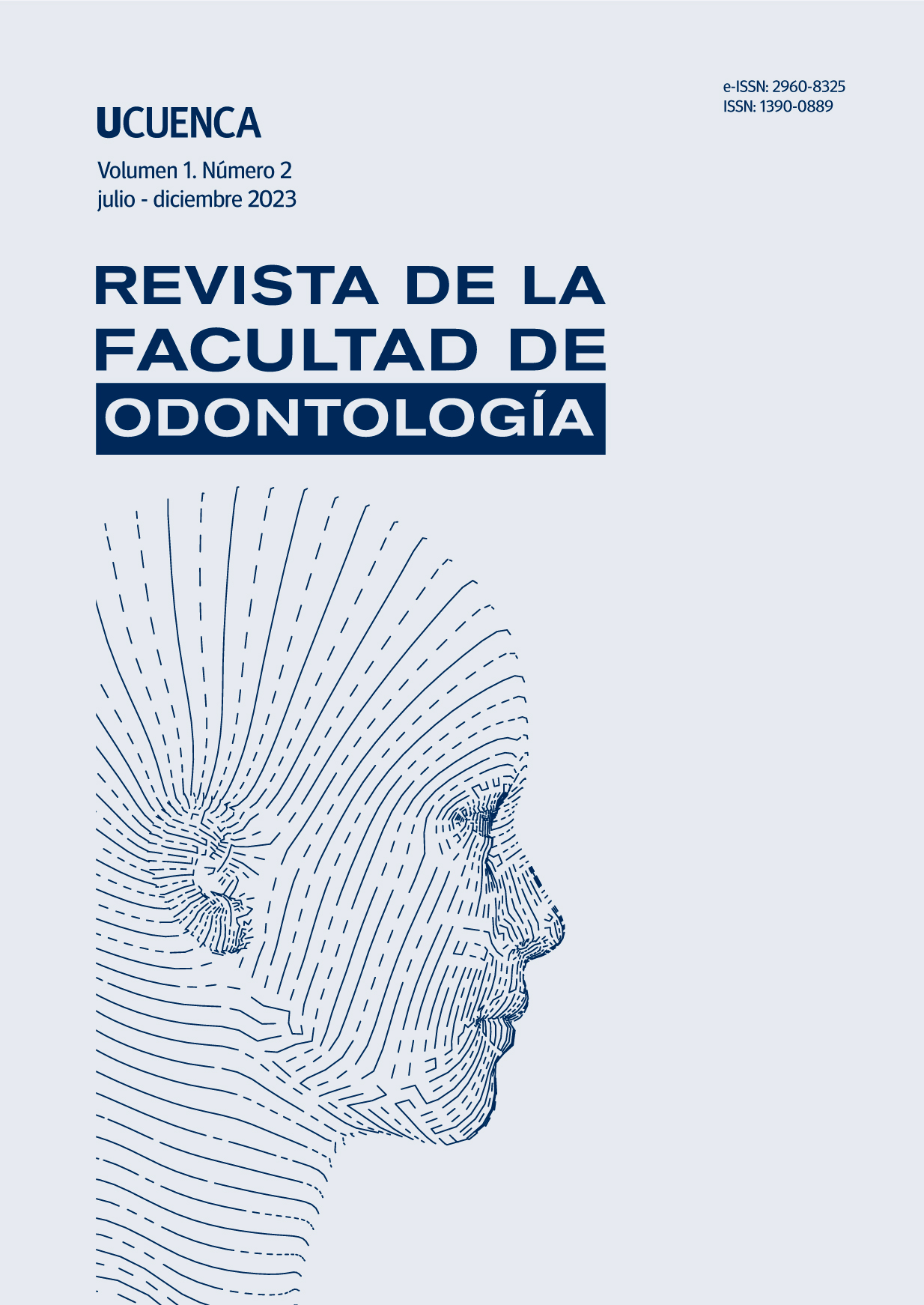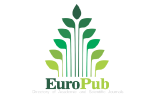Efecto del tratamiento térmico del silano en la fuerza de unión entre un composite nanocerámico y un cemento resinoso
DOI:
https://doi.org/10.18537/fouc.v01.n02.a01Palabras clave:
fuerza de unión, silano, adhesión dental, resina dentalResumen
El proceso de activación del silano ha sido identificado como generador de subproductos que impactan la fuerza de unión (FU) entre un cemento resinoso y un sustrato cerámico. Objetivo: evaluar la FU entre un composite nanocerámico y un cemento resinoso al emplear silano precalentado entre ellos. Materiales y métodos: se utilizaron 40 laminados para CAD/ CAM (Brava Block) distribuidos en cuatro grupos (n = 10) con diferentes tratamientos superficiales. El grupo de control (GC) fue sometido a chorro de arena + silano + adhesivo universal. G24: Arenado + silano a temperatura ambiente + adhesivo universal. G100-3. Chorro de arena + silano calentado a 1000 C durante 3 minutos + adhesivo universal. G100-5: Chorro de arena + silano calentado a 1000 C durante 5 minutos + adhesivo universal. Se cementaron cuatro microtubos de resina (llis. FGM) con cemento resinoso en cada laminado. Dos microtubos se ensayaron inmediatamente y los otros, después de un periodo de envejecimiento. Se aplicó una prueba de microcizallamiento en la máquina de ensayos universal. Los datos se analizaron estadísticamente con ANOVA y la prueba posthoc de Tukey con un α = 0,05. Resultados: los grupos G100-3 y G100-5 lograron los valores más altos de FU. (62,67; 64,16 MPa), mientras que los GC y G24 exhibieron los valores más bajos (38,50; 48,94 MPa). Incluso después del envejecimiento, la FU se mantuvo elevada en los grupos G100-3 y G100-5 (56,80; 57,10 MPa). Conclusiones: el tratamiento térmico del silano antes de cementar un composite de nanocerámica puede mejorar su fuerza de unión.
Descargas
Citas
Sannino G, Germano F, Arcuri L, Bigelli E, Arcuri C, Barlattani A. Cerec CAD/CAM chairside system. ORAL Implantol. 2014;7(3):57.
Badawy R, El-Mowafy O, Tam LE. Fracture toughness of chairside CAD/CAM materials–Alternative loading approach for compact tension test. Dent Mater. 2016;32(7):847-852.
Ardu S, Duc O, Di Bella E, Krejci I. Color stability of recent composite resins. Odontology. 2017;105:29-35.
Chuenjit P, Suzuki M, Shinkai K. Effect of various surface treatments on the bond strength of resin luting agent and the surface roughness and surface energy of CAD/CAM materials. Dent Mater Jo. 2021;40(1):16-25.
Teshigawara D, Ino T, Otsuka H, Isogai T, Fujisawa M. Influence of elastic modulus mismatch between dentin and post-and- ore on sequential bonding failure. J Prosthodont Res. 2019;63(2):227-31.
Goujat A, Abouelleil H, Colon P, Jeannin C, Pradelle N, Seux D, et al. Mechanical properties and internal fit of 4 CAD-CAM lock materials. J Prosthet Dent. 2018;119(3):384-9.
Moura DMD, Araújo AMMd, Souza KBd, Veríssimo AH, Tribst JPM. Hydrofluoric acidconcentration, time and use of hosphoric acid on the bond strength of feldspathic ceramics. Braz Oral Res. 2020;34.
Dimitriadi M, Zafiropoulou M, Zinelis S, Silikas N, Eliades G. Silane reactivity and resin bond strength to lithium disilicate ceramic surfaces. Dent Mater. 2019;35(8):1082-94.
Park J-H, Choi Y-S. Microtensile bond strength and micromorphologic analysis of surface-treated resin nanoceramics. J Adv Prosthodont. 2016;8(4):275-284.
Abouelleil H, Colon P, Jeannin C, Goujat A, Attik N, Laforest L, et al. Impact of the microstructure of CAD/CAM blocks on the bonding strength and the bonded interface. J Prosthodont. 2022;31(1):72-78.
lsaka SE, Elnaghy AM. Effect of Surface Treatment and Aging on Bond Strength of Composite Cement to Novel CAD/CAM Nanohybrid Composite. J Adhes Dent. 2020;22(2).
Reymus M, Roos M, Eichberger M, Edelhoff D, Hickel R, Stawarczyk B. Bonding to new CAD/CAM resin composites: influence of air abrasion and conditioning agents as pretreatment strategy. Clin Oral Investig. 2019;23:529-538.
Kay Khine PP, Tichy A, Abdou A, Hosaka K, Sumi Y, Tagami J, et al. Influence of Silane Pretreatment and Warm Air-Drying on Long-Term Composite Adaptation to Lithium Disilicate Ceramic. Crystals. 2021;11(2):86.
Çelik E, Şahin SC, Dede DÖ. Effect of surface treatments on the bond strength of indirect resin composite to resin matrix ceramics. J Adv Prosthodont. 2019;11(4):223-31.
Niem T, Youssef N, Wöstmann B. Influence of accelerated ageing on the physical properties of CAD/CAM restorative materials. Clin Oral Investig. 2020;24:2415-25.
Schrader ME. Radioisotopic studies of bonding at the interface. J Adhesion. 1970;2(3):202-12.
Matinlinna JP, Lung CYK, Tsoi JKH. Silane adhesion mechanism in dental applications and surface treatments: A review. Dent Mater. 2018;34(1):13-28.
Soleimani L, Alaghemand H, Fatemi SM, Esmaeili B. Effect of heat treatment and addition of 4-META to silane on microtensile bond strength of IPS e. max CAD ceramic to resin cement. Dent Res J (Isfahan) 2019;16(5):318.
Carvalho RFd, Cotes C, Kimpara ET, Leite FPP. Heat treatment of pre-hydrolyzed silane increases adhesion of phosphate monomer-based resin cement to glass ceramic. Braz Dent J. 2015;26:44-9.
Del Piñal Luna M, Molina IC, de Vasconcellos DK, Volpato CÁM, Suárez MJ. Consideraciones mecánicas y biológicas sobre el envejecimiento del óxido de circonio odontológico. Revista internacional de prótesis estomatológica, ISSN 1139-9791, Vol. 16, Nº. 1, 2014, págs. 15-23
Silva L, Costa A, Queiroz J, Bottino M, Valandro L. Ceramic primer heat-treatment effect on resin cement/Y-TZP bond strength. Oper Dent. 2012;37(6):634-40.
Yanakiev SS, Marinova-Takorova MB. Silane heat treatment could eliminate the hydrofluoric acid etching of lithium disilicate overlays: a four-year follow-up. Case Rep Dent. 2021;2021.
Abduljabbar T, AlQahtani MA, Jeaidi ZA, Vohra F. Influence of silane and heated silane on the bond strength of lithium disilicate ceramics - An in vitro study. Pak J Med Sci. 2016;32(3):550-4.
Hakimaneh SMR, Shayegh SS, Ghavami‐Lahiji M, Chokr A, Moraditalab A. Effect of silane heat treatment by laser on the bond strength of a repair composite to feldspathic porcelain. J Prosthodont. 2020;29(1):49-55.
Al-Thagafi R, Al-Zordk W, Saker S. Influence of Surface Conditioning Protocols on Reparability of CAD/CAM Zirconia-reinforced Lithium Silicate Ceramic. J Adhes Dent. 2016;18(2):135-41.
Maruo Y, Nishigawa G, Yoshihara K, Minagi S, Matsumoto T, Irie M. Does 8-methacryloxyoctyl trimethoxy silane (8-MOTS) improve initial bond strength on lithium disilicate glass ceramic? Dent Mater. 2017;33(3):e95-e100.
Quiroz Cevallos G, Chacón Flores L, Guevara Guamán K, Celi Gonzaga M, Cangas Bedoya P, Quinapallo López V, et al. Influencia del arenado sobre la resistencia adhesiva de un polímero HPP para CAD CAM. 2022. Odontol Activa.2022; 7 (1):17-24
Schneider LF. Avaliação da estabilidade de cor de uma resina nanocerâmica submetida a intervenções de higiene e imersão em café. 2020.repositorio.ufsc.br
Maier E, Bordihn V, Belli R, Taschner M, Petschelt A, Lohbauer U, et al. New Approaches in Bonding to Glass-Ceramic: Self-Etch Glass-Ceramic Primer and Universal Adhesives. J Adhes Dent. 2019;21(3).
Yao C, Yang H, Yu J, Zhang L, Zhu Y, Huang C. High bond durability of universal adhesives on glass ceramics facilitated by silane pretreatment. Oper Dent. 2018;43(6):602-12.32.
Carrilho E, Cardoso M, Marques Ferreira M, Marto CM, Paula A, Coelho AS. 10-MDP based dental adhesives: adhesive interface characterization and adhesive stability—a systematic review. Materials. 2019;12(5):790.
Hoshika S, Kameyama A, Suyama Y, De Munck J, Sano H, Van Meerbeek B. GPDM-and 10-MDP-based Self-etch Adhesives Bonded to Bur-cut and Uncut Enamel. J Adhes Dent. 2018;20(2):113-20.
Descargas
Publicado
Cómo citar
Número
Sección
Licencia
Derechos de autor 2023 Revista de la Facultad de Odontología de la Universidad de Cuenca

Esta obra está bajo una licencia internacional Creative Commons Atribución-NoComercial-CompartirIgual 4.0.











